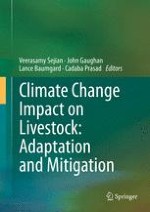2015 | OriginalPaper | Chapter
3. Contribution of Agriculture Sector to Climate Change
Authors : Sangeeta Lenka, N. K. Lenka, Veerasamy Sejian, M. Mohanty
Published in: Climate Change Impact on Livestock: Adaptation and Mitigation
Publisher: Springer India
Activate our intelligent search to find suitable subject content or patents.
Select sections of text to find matching patents with Artificial Intelligence. powered by
Select sections of text to find additional relevant content using AI-assisted search. powered by
